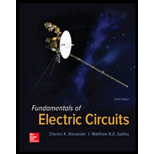
Concept explainers
(a)
Find the Fourier transform of
(a)
Answer to Problem 35P
The Fourier transform of
Explanation of Solution
Given data:
Formula used:
Consider the general form of Fourier transform of
Consider the general form of inverse Fourier transform of
Consider scaling property.
Consider Time shift property.
Calculation:
Modify equation (1) as follows.
Substitute
From scaling and time shift property, equation (1) can be write as follows.
Substitute
Conclusion:
Thus, the Fourier transform of
(b)
Find the Fourier transform of
(b)
Answer to Problem 35P
The Fourier transform of
Explanation of Solution
Given data:
Formula used:
Consider Modulation property.
Calculation:
Modify equation (1) as follows.
Substitute
From modulation property, equation can be write as follows.
Conclusion:
Thus, the Fourier transform of
(c)
Find the Fourier transform of
(c)
Answer to Problem 35P
The Fourier transform of
Explanation of Solution
Given data:
Formula used:
Consider Time differentiation property.
Calculation:
Modify equation (1) as follows:
Substitute
From modulation property, equation can be write as follows:
Conclusion:
Thus, the Fourier transform of
(d)
Find the Fourier transform of
(d)
Answer to Problem 35P
The Fourier transform of
Explanation of Solution
Given data:
Formula used:
Consider Convolution in t property.
Calculation:
Modify equation (1) as follows.
Substitute
From Convolution in t property, equation can be write as follows.
Conclusion:
Thus, the Fourier transform of
(e)
Find the Fourier transform of
(e)
Answer to Problem 35P
The Fourier transform of
Explanation of Solution
Given data:
Formula used:
Consider Frequency differentiation property.
Calculation:
Modify equation (1) as follows.
Substitute
From Frequency differentiation property, equation can be write as follows.
Simplify the equation as follows.
Conclusion:
Thus, the Fourier transform of
Want to see more full solutions like this?
Chapter 18 Solutions
Fundamentals of Electric Circuits
- Signals and Systems Calculate the fourier transform of y(n) in terms of x(t)'s fourier transforms (X (jw).) Note : Substitute t for n for the range in the piecewise function. (misspelled as n in the ımage)arrow_forwardThe Fourier transform of a continuous-time signal x(t) is denoted by X(ω). Apply CTFT properties to obtain the Fourier Transform of x(3t+7).arrow_forwardThe Fourier transform of the signal is real (real) as X (jw) = 2a / (a² + w²) as previously found. It has no complex part. What is the reason of this?arrow_forward
- Calculate the Fourier transform of cos(2πnt)arrow_forwardFind by calculating the convolution of x(t) and h(t) in the form y(t)=x(t)*h(t). Calculate the inverse Fourier transform of the product of the Fourier transforms of x(t) and h(t) in the formarrow_forwardFind the Fourier series representation of f(t) = 1 + t, −π < t < π , period 2π .arrow_forward
- x [n] = [1,5,2,3,3,1,2,3]Find the Fourier coefficients for the discrete time signal given by the fast Fourier transform.arrow_forwardx(t) = cos(20π/3t) + sin(15π/4t) Calculate the Fourier transform and draw the frequency domain representation.arrow_forwardsignal and systems, I need it ASAP please. Answer for b (A)Using the Fourier Integral, find the Fourier Transform of the following signal: f(t) = 1/2 * [delta(t + 10) + delta(t - 10)] (B)Using the Fourier Transform, integral, pairs and properties, evaluate: f(t)=cos(24t).sin(64t)arrow_forward
- Find the Fourier transform X(ω) of the signal x(t) = sin(at) knowing that X(ω) has rectangular shapearrow_forwardDetermine the Fourier transform of the following signals Thanksarrow_forwardRegarding Signals and Systems, given a signal x(t) = |cos(ωt)| for ω>0. Find the Fourier transform of x(t). Please do not ignore the absolute value operator (that is what I am struggling with.arrow_forward
 Introductory Circuit Analysis (13th Edition)Electrical EngineeringISBN:9780133923605Author:Robert L. BoylestadPublisher:PEARSON
Introductory Circuit Analysis (13th Edition)Electrical EngineeringISBN:9780133923605Author:Robert L. BoylestadPublisher:PEARSON Delmar's Standard Textbook Of ElectricityElectrical EngineeringISBN:9781337900348Author:Stephen L. HermanPublisher:Cengage Learning
Delmar's Standard Textbook Of ElectricityElectrical EngineeringISBN:9781337900348Author:Stephen L. HermanPublisher:Cengage Learning Programmable Logic ControllersElectrical EngineeringISBN:9780073373843Author:Frank D. PetruzellaPublisher:McGraw-Hill Education
Programmable Logic ControllersElectrical EngineeringISBN:9780073373843Author:Frank D. PetruzellaPublisher:McGraw-Hill Education Fundamentals of Electric CircuitsElectrical EngineeringISBN:9780078028229Author:Charles K Alexander, Matthew SadikuPublisher:McGraw-Hill Education
Fundamentals of Electric CircuitsElectrical EngineeringISBN:9780078028229Author:Charles K Alexander, Matthew SadikuPublisher:McGraw-Hill Education Electric Circuits. (11th Edition)Electrical EngineeringISBN:9780134746968Author:James W. Nilsson, Susan RiedelPublisher:PEARSON
Electric Circuits. (11th Edition)Electrical EngineeringISBN:9780134746968Author:James W. Nilsson, Susan RiedelPublisher:PEARSON Engineering ElectromagneticsElectrical EngineeringISBN:9780078028151Author:Hayt, William H. (william Hart), Jr, BUCK, John A.Publisher:Mcgraw-hill Education,
Engineering ElectromagneticsElectrical EngineeringISBN:9780078028151Author:Hayt, William H. (william Hart), Jr, BUCK, John A.Publisher:Mcgraw-hill Education,





